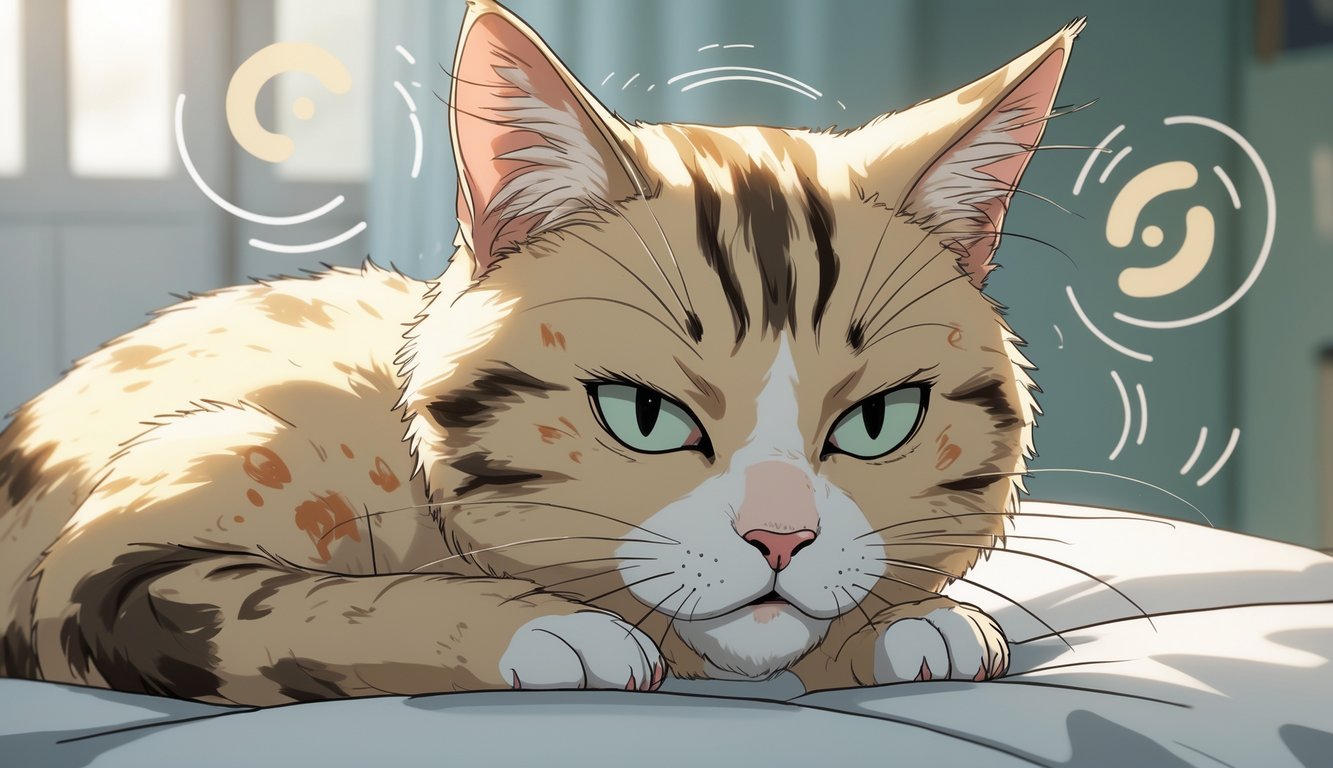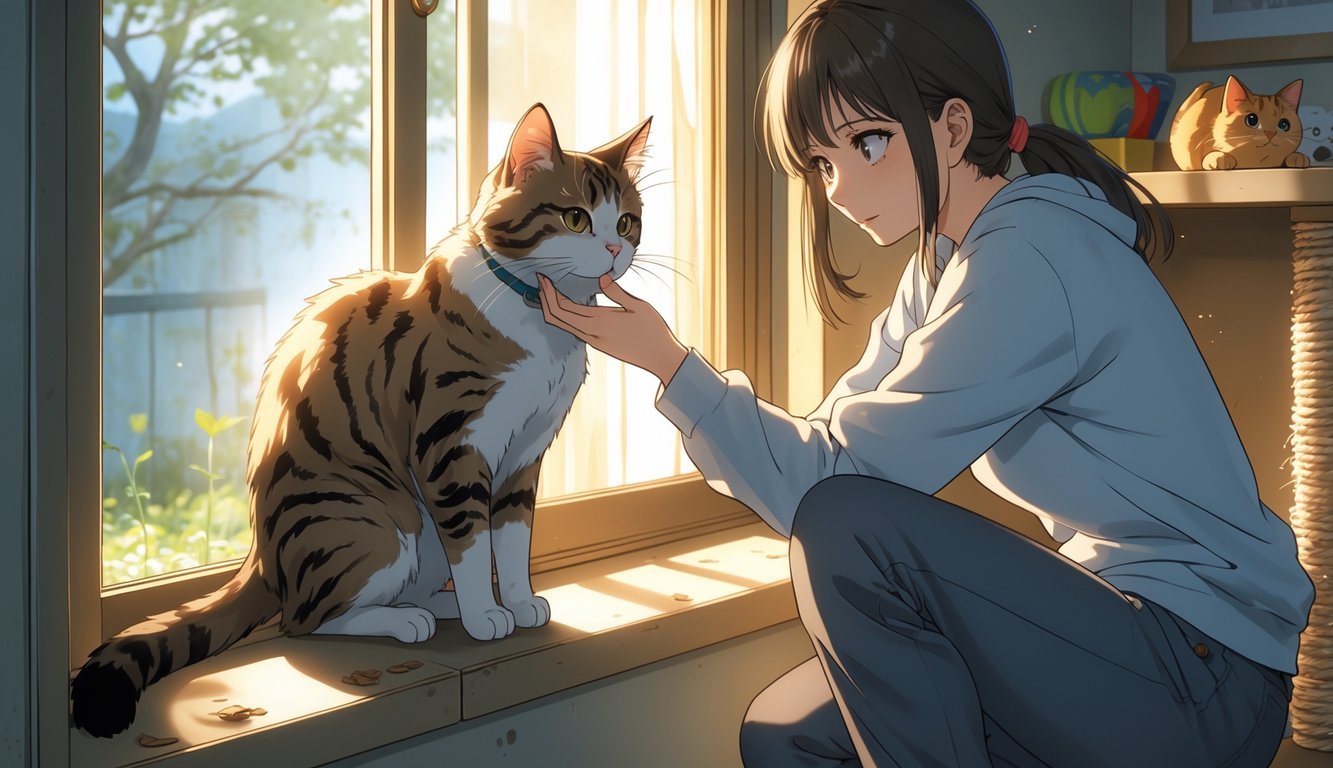PsychNewsDaily Publishers
100 Summit Drive
Burlington, MA, 01803
Telephone: (320) 349-2484
PsychNewsDaily Publishers
100 Summit Drive
Burlington, MA, 01803
Telephone: (320) 349-2484
Cats often hide stress signals, such as increased vocalizations, excessive grooming, and changes in appetite, which can lead to health and behavioral issues if overlooked.

Cats have a knack for hiding their feelings, so it’s easy to miss when something’s off. Stress can creep in quietly, and if you overlook the early signs, things might spiral into bigger health or behavior headaches.
Learning to pick up on stress signals before they get out of hand really helps you look out for your cat’s well-being—and honestly, it just makes life smoother for both of you.
You’ll spot how things like changes in grooming, eating, or mood give away what your cat’s dealing with. If you start noticing these things, you can make small changes that’ll seriously improve your cat’s comfort and health.
This guide covers the most common signs to watch for and helps you figure out when it’s time to get extra help.

Maybe your cat suddenly won’t stop meowing, yowling, or even howling. Sure, some cats are chatty by nature, but if you notice them getting noisier out of nowhere, it could mean they’re stressed.
Your cat might just be trying to let you know they’re uneasy, frustrated, or overwhelmed. Stuff like moving furniture, new faces in the house, or even just getting less attention can set them off.
Vocalizing can sometimes connect to health issues—pain or illness can change how your cat sounds or acts. If their voice seems off or they’re restless while calling out, it’s a good idea to keep a closer eye.
Try looking for possible triggers in their environment. Giving them safe spots, sticking to routines, and offering extra comfort can help tone down the noise.
If the meowing keeps up or gets worse, maybe check in with your vet to rule out anything medical.

Sometimes you’ll see your cat licking or chewing the same area over and over. Grooming’s normal, but when it goes overboard, it can leave bald spots or irritated skin—usually a sign something’s bugging them.
Stress, boredom, or allergies can all cause this. Your cat might try to calm themselves, but too much licking just makes things worse by hurting their skin.
Watch for thinning fur, redness, or little sores. These usually mean grooming has crossed the line from normal cleaning.
Pay attention to where and when your cat grooms. Some focus on their belly or legs, others go for the sides or tail.
If you spot bald spots or irritation, it’s probably time for a vet visit. They can rule out medical problems and help you figure out how to reduce stress or remove triggers.

Your cat might start slipping under the bed, behind furniture, or into closets more than usual. Some cats just like quiet spaces, but if they’re suddenly hiding a lot, they probably feel uneasy.
If your cat usually greets you or hangs out with other pets but now dodges everyone, take note. Changes at home, loud noises, or new animals can all make them withdraw.
Sometimes they’ll avoid being touched or picked up, even if they used to love it. It’s not about them disliking you—they just need space to feel safe.
Try to notice when and where your cat hides. Those patterns can clue you in to what’s bothering them and help you tweak things to lower their stress.

If your cat suddenly eats way less or more than usual, that’s a big red flag. Appetite shifts often point to stress, though sometimes it’s a health thing too.
Stress can make cats lose interest in food. They might walk away at mealtime or just nibble a bit, especially after something in their routine changes or there’s a lot of noise.
Some cats do the opposite and eat more when stressed, using food for comfort. If your cat’s begging for food more often or scarfing down meals, stress might be the reason.
Keep an eye on how long it lasts. Missing a meal or two after a stressful day isn’t always a big deal, but if it keeps happening, a vet check is smart.

You might see your cat hiss, growl, or swat at you out of nowhere. These sudden moves usually mean your cat’s stressed, feels threatened, or just got overstimulated.
Sometimes, your cat lashes out during play, while you’re petting them, or if another pet gets too close. Swatting, scratching, or even biting is their way of saying, “Back off, I need space.”
Aggression might show up as blocking doorways or chasing other pets. It’s often about territory or social pecking order. Noticing when and where it happens helps you spot the trigger.
If your cat suddenly gets aggressive, don’t punish them. Give them some room to chill out. Stress, changes at home, or even pain from a health issue can all cause this.
Catching these signs early lets you make changes before things get out of hand. Adjusting the environment and lowering stress can help your cat feel safer.

You might catch your cat walking back and forth, never really settling. They might do it in one room or all over the house. Usually, this means your cat can’t relax or feels uneasy.
Stress from things like changes in routine, new faces, or loud sounds can make cats restless. They really prefer predictability, so even small changes can set them pacing.
Sometimes, medical problems cause restlessness. Pain or certain illnesses might make your cat pace. If it keeps happening and you can’t figure out why, a vet visit makes sense.
Boredom can also play a role. Try offering toys, scratching posts, or some quick play sessions to help them burn off energy.
If your cat paces at night, it could be aging or confusion. Older cats sometimes change their sleep and activity patterns. Keep an eye on when and how often your cat paces—it’ll help you figure out what’s up.

If your cat starts peeing outside the litter box, stress might be the culprit. Cats can react to changes like a new pet, moving stuff around, or just a shift in your schedule by avoiding the box—even if it’s spotless.
Of course, sometimes there’s a medical reason, so always check with your vet first. Things like urinary tract infections or bladder issues can cause accidents. But if your cat’s healthy, stress or anxiety is often behind it.
You might notice your cat picking certain spots, like the bed or bathtub. It could be about marking territory or just finding somewhere that feels safer.
Try keeping the litter box extra clean and in a quiet spot. Make sure your cat has safe places to hide when things get overwhelming. Lowering stress at home usually helps get litter box habits back on track.

If your cat’s pupils suddenly get huge, they’re probably anxious or scared. It happens even when the lights are normal, so it’s not just about the room being dark.
Flattened ears are another giveaway. When your cat pushes their ears back tight to their head, they usually feel threatened or uneasy.
Sometimes you’ll see both at once—wide eyes and flat ears. That’s your cat on high alert, maybe ready to defend themselves.
These signs pop up during loud noises, new visitors, or sudden changes. Catching them early helps you step in before your cat gets too stressed.
If you see these signs a lot, try to figure out what’s causing them. Cutting down on triggers and giving your cat safe spots to hide can really help.

Stress changes both your cat’s behavior and their health. Some reactions show up fast and fade, but others build up and can lead to illness or bigger problems.
When your cat feels stressed, their body releases hormones like cortisol and adrenaline. These hormones prep them for threats, but if stress sticks around, it can really take a toll.
You might notice they eat less or skip meals. Digestive issues, like vomiting or diarrhea, can show up too. Stress can even mess with the urinary system, causing accidents or bladder problems.
Their skin and coat might suffer as well. Overgrooming leads to bald spots, while some cats just stop grooming and end up with a dull coat. Stress weakens the immune system, so your cat might get sick more easily.
Common health effects linked to stress:
Short-term stress usually comes from sudden stuff—loud noises, a vet trip, or someone new in the house. Your cat might hide, hiss, or pace, but once things calm down, they usually bounce back.
Long-term stress is different. It’s the result of ongoing issues, like not having safe spaces, fighting with another pet, or constant changes in routine. This kind of stress builds up and can cause lasting health or behavior problems.
Watch for patterns. One stressful event probably won’t hurt your cat, but if they’re always stressed, it can lead to chronic issues like weight loss, aggression, or repeated urinary trouble.
Key differences:
| Short-Term Stress | Long-Term Stress |
|---|---|
| Triggered by sudden events | Triggered by ongoing conditions |
| Signs fade after trigger ends | Signs persist or worsen over time |
| Usually less harmful | Can lead to illness and behavior changes |

Some stress behaviors you can handle at home, but others mean it’s time for professional help. Knowing which warning signs need urgent attention—and being able to clearly tell your vet what’s happening—gets your cat the right support, fast.
Sometimes, your cat’s behavior or physical changes can be a big red flag. If your cat refuses to eat for over 24 hours, that’s a problem—liver issues can pop up fast and you’ll want to act quickly.
Keep an eye out for labored breathing, frequent vomiting, diarrhea with blood, or a sudden collapse. Those symptoms aren’t just stress—they usually mean something serious is going on.
Cats are pros at hiding pain, which makes things trickier. If your cat keeps hiding, won’t move, or cries out when you touch them, don’t brush it off.
Here’s a quick checklist you can use:
If you spot any of these signs, reach out to your vet right away. Don’t just wait and hope things get better.
When you take your cat to the vet, the details you share really matter. Try to note when the stress signs started and how often you see them.
Think about what sets off these behaviors. Jot down any changes in eating, litter box use, grooming, or sleep.
If you can, snap a photo or record a quick video of anything odd your cat does. That way, your vet sees what you see—sometimes it’s hard to explain everything in words.
Let your vet know about changes at home, even if they seem small. Did you move furniture? Bring in a new pet? Maybe there’s more noise than usual?
Little things can sometimes reveal whether stress is the problem or if something medical is going on.
When you offer specific details, you help your veterinarian figure out what’s happening and how to help your cat feel better.